Barbell training is a one-stop-shop for strength, more muscle mass, fat loss, and power. That’s because you can load up the barbell with more weight than kettlebells and dumbbells can provide. The almighty barbell — which has a rich history in strength sports — can also be used in various ways — you can squat it, press it, load it on your back or your front, and even jump with it.
The thing is, there are so many exercises available today that knowing which to focus on if you’re new to using barbells can be overwhelming.

Below, we outline the 15 best barbell exercises to add to your training, along with the benefits of barbell training and how to warm up before hoisting a barbell.
15 Best Barbell Exercises
- Barbell Back Squat
- Barbell Front Squat
- Barbell Bench Press
- Barbell Rack Pull
- Barbell Romanian Deadlift
- Barbell Bent Over Row
- Barbell Push Press
- Barbell Hip Thrust
- Barbell Floor Press
- Barbell Biceps Curl
- Barbell Hang Clean
- Barbell Good Morning
- Barbell Kirk Shrug
- Barbell Overhead Carry
- Barbell Skull Crusher
1. Barbell Back Squat
The back squat is called the “king of all exercises” for a reason. Squatting with a heavy barbell on your back allows you to overload your leg muscles with more weight than you could with other tools. Your core works overtime as you brace to ensure that your torso is rigid throughout the movement (which promotes a stable and safe spine). And your back, which is supporting the physical load, will also reap some strength gains.
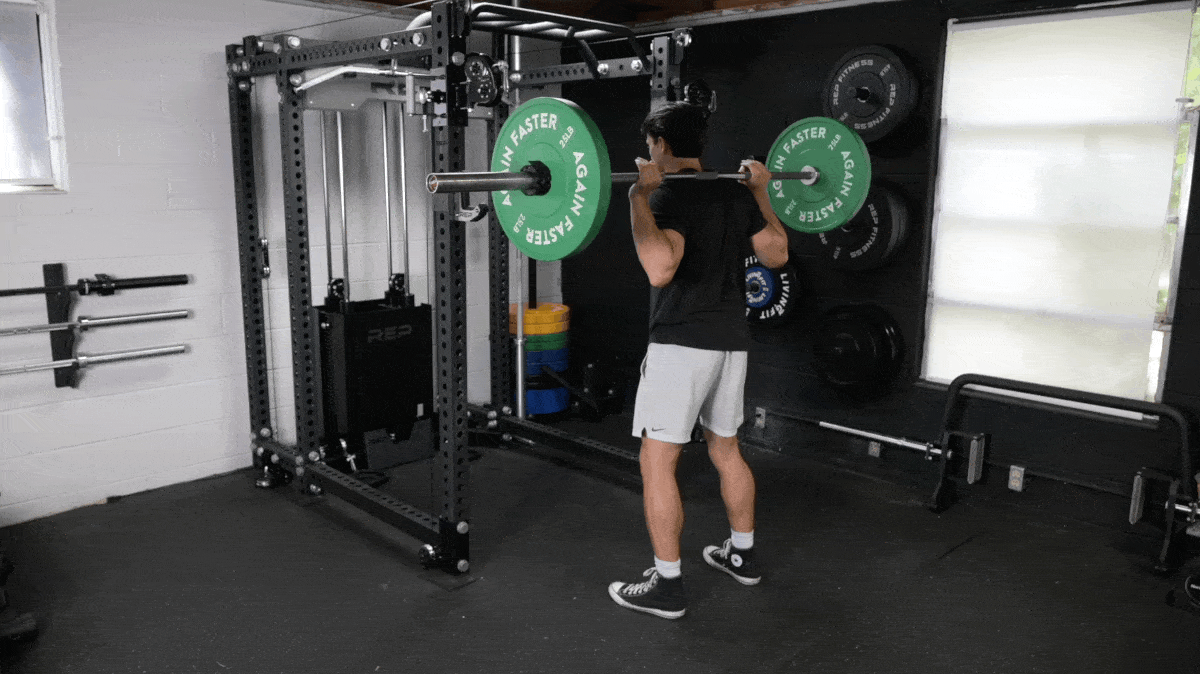
Back squats are also great for both heavy, low-rep training or lighter, high-rep training. Higher rep squats (and lower rep but not to the same extent) cause the body to produce more growth hormones that trigger the effect of increasing your overall size and strength, as well as improving your explosive power. (1)(2)
How to Do It
- Step under a barbell and set a good foundation by flexing your core to lift the barbell off the squat rack.
- Grip the barbell wherever allows you optimal shoulder mobility to get your elbows under the bar.
- Set it either high or low on your upper back, unrack it, and take a few steps back.
- Pull the bar down into your shoulders to create tension.
- Keep your chest up, take a deep breath in and squat down to a comfortable depth and pause for a beat.
- Drive your feet through the floor until lockout.
Coach’s Tip: Take time to experiment with stance width and foot position to find something comfortable for you.
Sets and Reps: Try 3 sets of 6-8 reps.
2. Barbell Front Squat
You may be thinking, “wait, do we really need two squats on this list?” Yes, and here’s why: Though they’re both squatting patterns, the front squat has you support the barbell in the front rack position, resting across your shoulders.
This position takes the load off your back, reduces spinal compression, and forces you to contract your upper back muscles better to prevent the bar from falling forward mid-lift. Compared to the back squat, the front squat trains the body’s anterior muscles more heavily, engaging the quads and anterior core to a greater degree.
How to Do It
- Assume a proper front rack position by putting the barbell high up onto the shoulders, ensuring the bar is supported with the shoulders and upper chest.
- Keep your shoulders down and chest up and take three steps back from the rack.
- Descend into a squat keeping the back in neutral while minimizing forward lean of the torso.
- Once you have hit the bottom position, push through the whole foot and stand up, maintaining an upright torso, chest, and forward elbow position.
Coach’s Tip: Think about “showing your armpits” to the mirror in front of you to maintain your front rack.
Sets and Reps: Go for 3 sets of 8 to 10 reps.
3. Barbell Rack Pull
The rack pull is a deadlift variation similar that trains all the same muscles in the standard deadlift but with a reduced range of motion (ROM). For rack pulls, you start with the barbell at or just below knee height. You can elevate the barbell on blocks, weight plates, or the safety arms of a power rack.
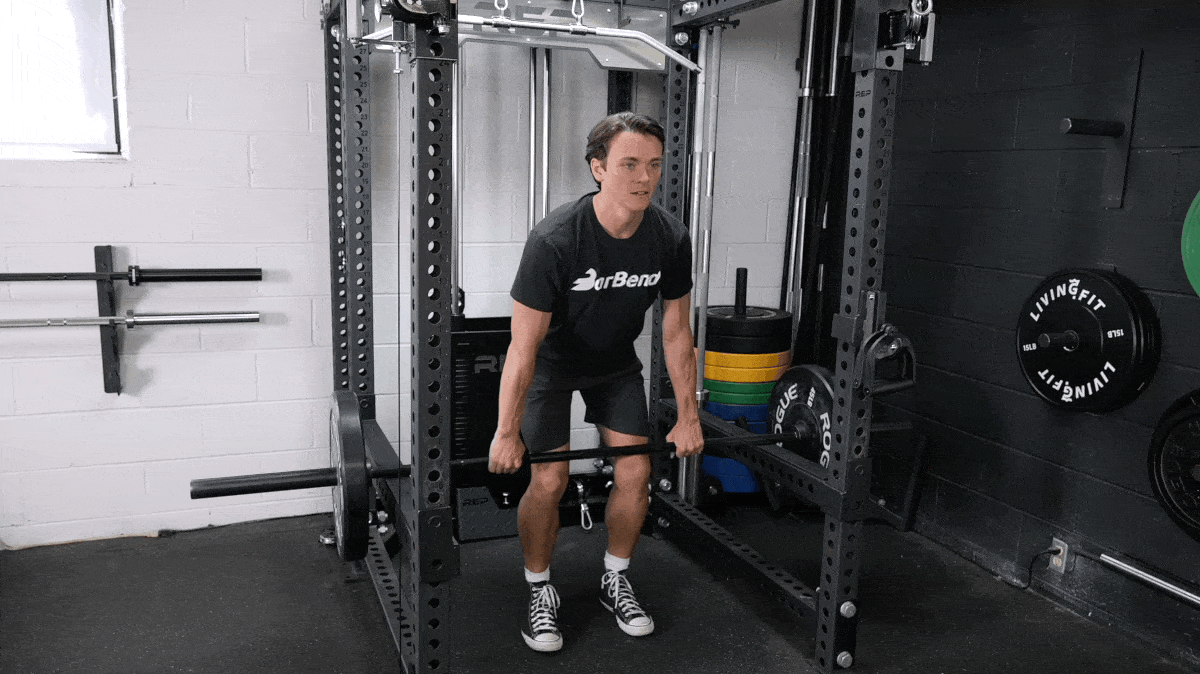
[Read More: The Single-Leg Deadlift Is the Best Pulling Accessory You’re Not Doing]
Because of the reduced range of motion, it’s easier to maintain a neutral spine. Plus, you can use more weight with the rack pull, so it both acclimates your body to handle heavy loads and strengthens the top half — or lockout — of your deadlift.
How to Do It
- Set the barbell up in the squat rack either above or below the knees. Assume your standard deadlift stance and grip.
- Hinge down and grip the barbell with an overhand shoulder-width grip and squeeze your armpits together, keep your chest up and shoulders back.
- Pull up until lockout, finishing with your glutes.
- Hinge back to the starting position and repeat.
Coach’s Tip: Go hard and heavy here, working with more weight than you can deadlift from the floor.
Sets and Reps: Do 4 to 5 sets of 3 to 5 reps.
4. Barbell Romanian Deadlift
This is our second deadlift variation on the list, and there’s a reason we chose both over the conventional version. Regarding the Romanian deadlift, it’s a bit more specific and beginner-friendly (similar to the rack pull.) The move is visually very similar to the standard deadlift, but the RDL has you lower the bar to about mid-shin level instead of back to the floor.
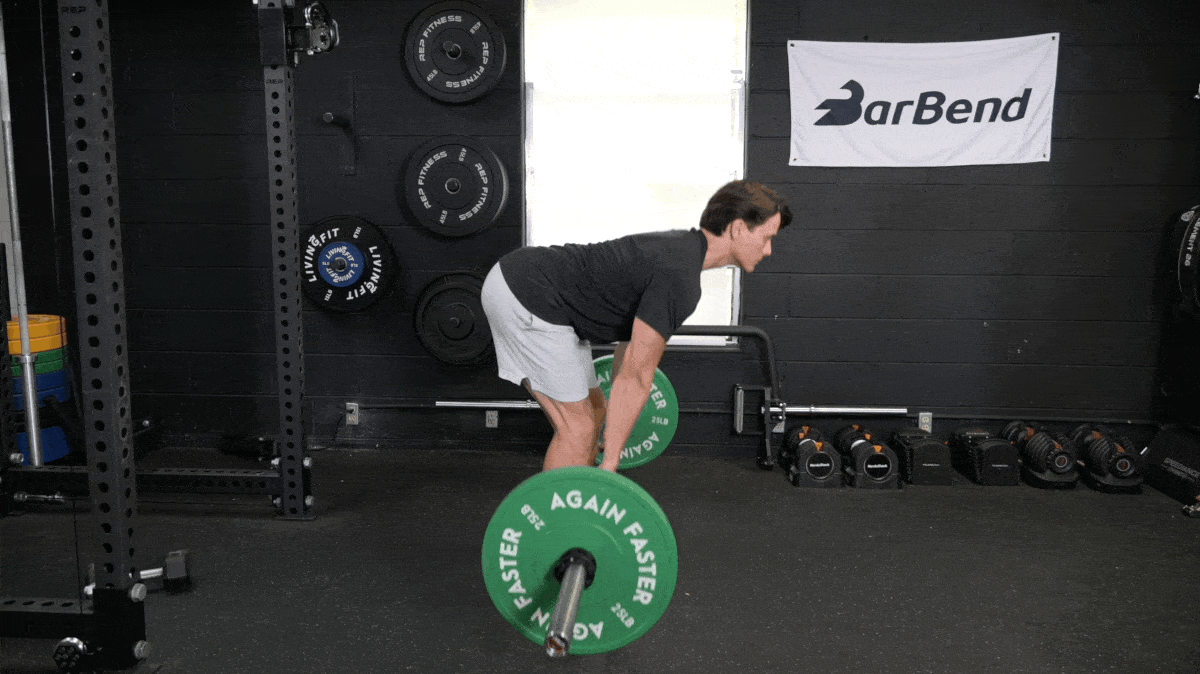
[Read More: Romanian Deadlift Vs. Deadlift — Which is Better for Your Program?]
This slight tweak keeps tension on the glute and hamstring muscles, making it a better option to isolate those areas and on the lower back. A stronger lower back will carry over to your deadlift and help prevent spinal rounding (or cat-back) during heavy pulls. The RDL is also generally safer as it doesn’t allow you to use much weight as your standard deadlift.
How to Do It
- Stand tall with your feet hip-distance apart and grip the barbell with an overhand grip in front of the thighs.
- With your chest up and shoulders down, take a deep breath in and hip hinge until the barbell is below your knees. Always keep the barbell close to your body.
- Pause for a second and exhale and use your hamstrings and glutes to pull you back to a standing position. Reset and repeat.
Coach’s Tip: Think about pushing your butt back toward an invisible wall behind you while you hinge.
Sets and Reps: Try 2 or 3 sets of 8 to 12 repetitions.
5. Barbell Bench Press
The bench press and all its variations (incline, decline, close-grip, with dumbbells, and the floor press) target the chest, triceps, and shoulders. Like most barbell exercises, it allows you to use a greater load (because of the relatively straight bar path and the stability of the bench) than you could muster with kettlebells or dumbbells.
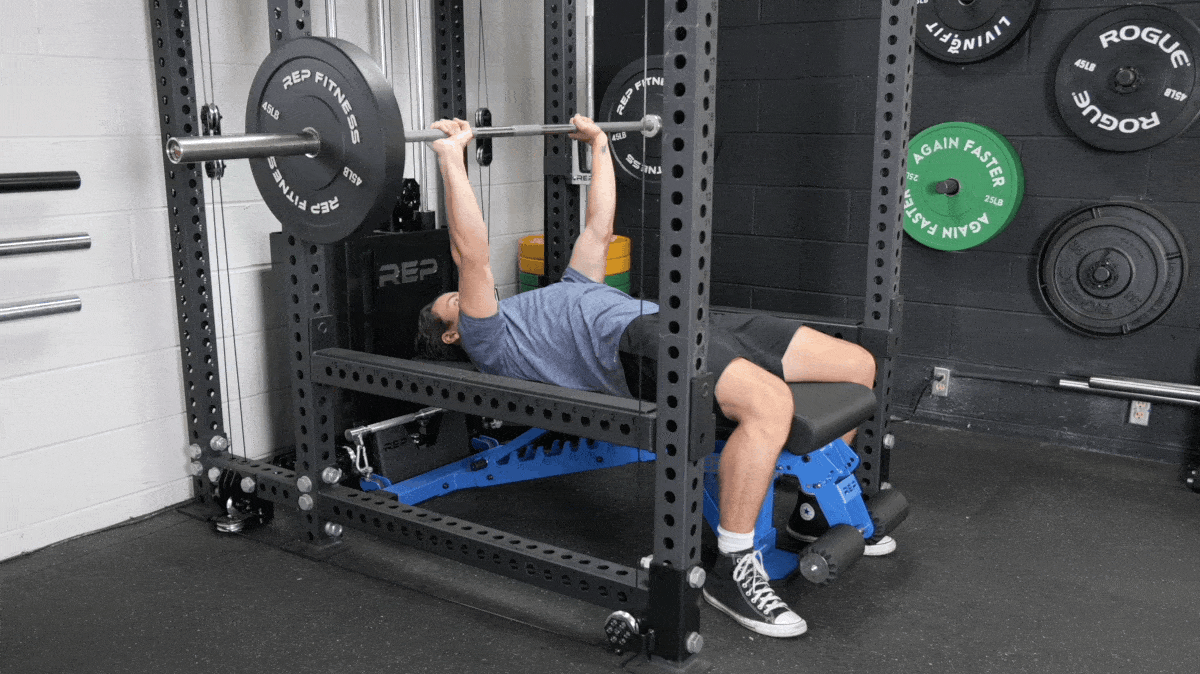
[Read More: Build a Titanic Torso with These Bodybuilding Chest & Back Workouts]
For powerlifters, this move is a must-do as it’s one of the three main competition lifts (the other two being the back squat and deadlift).
How to Do It
- Lie flat on your back on a weight bench and get your eyes directly underneath the barbell.
- Grip the bar with hands wider than shoulder-width apart with a neutral wrist.
- Bring your feet closer to your glutes, push your feet back and un-rack the bar in the lockout position.
- Then bring the bar slowly down to your chest, pause for a moment, and press it back to the starting position.
Coach’s Tip: The bar path of a bench press isn’t straight up and straight down; press up and backward slightly so the bar ends directly over your shoulders.
Sets and Reps: Try 4 sets of 8 reps.
6. Barbell Bent-Over Row
The bent over row is a fantastic exercise to strengthen and increase mass in the upper back and lats and reinforce good hip hinge mechanics. Because you’re in a hip hinge position, this trains the lower back isometrically, making it a great accessory exercise to improve your deadlift.
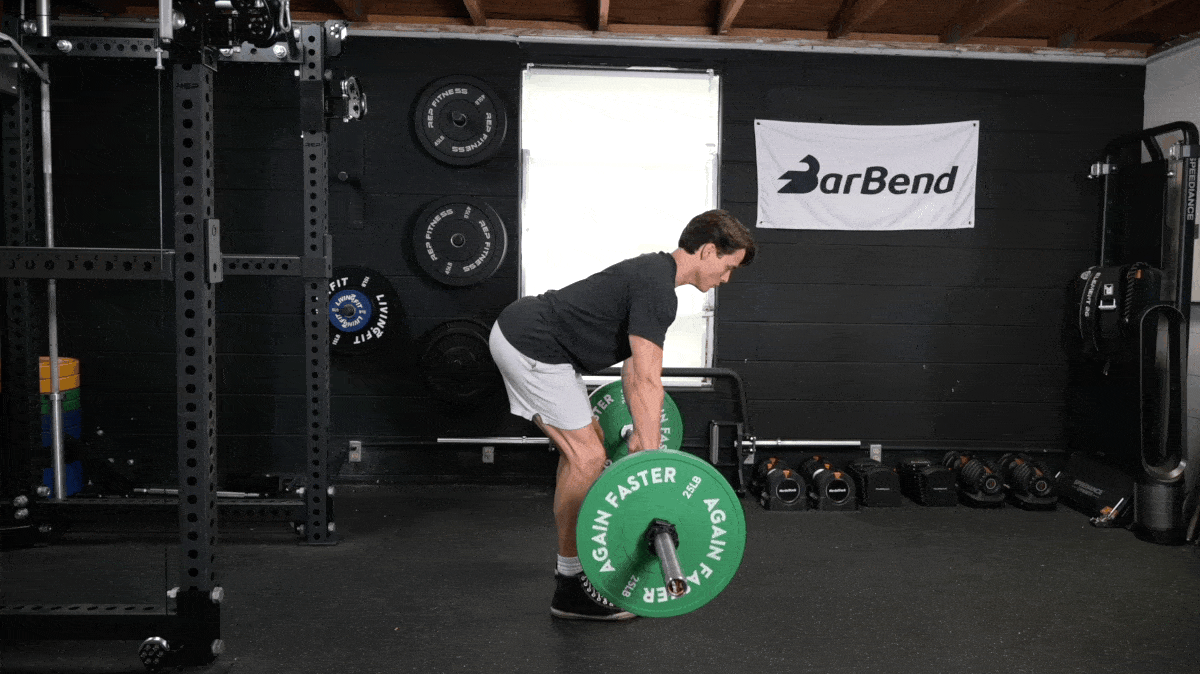
The bent-over row (and the Pendley row) is a horizontal row variation that allows you to use the most weight. In most cases, more weight equals more muscle and strength.
How to Do It
- Put a loaded barbell on the floor stand with your feet slightly more than hip-width apart.
- Hinge down to the barbell and grab the barbell with a shoulder-width grip.
- Then bring the barbell up to knee level with back straight and torso bent at 45 degrees.
- Pull the barbell to between your navel and sternum. Pause, then slowly lower the barbell back down and repeat.
Coach’s Tip: Your torso should be between parallel to the floor and a 45-degree angle.
Sets and Reps: Try 3 or 4 sets of 8 to 12 reps.
7. Barbell Push Press
The overhead press is a fantastic shoulder exercise, no doubt. But how often do you find yourself not moving your lower body to get something overhead? The push press uses the triple extension of the ankles, knees, and hips, which closely mimics what most overhead athletes do on the field and you do at home or the gym.
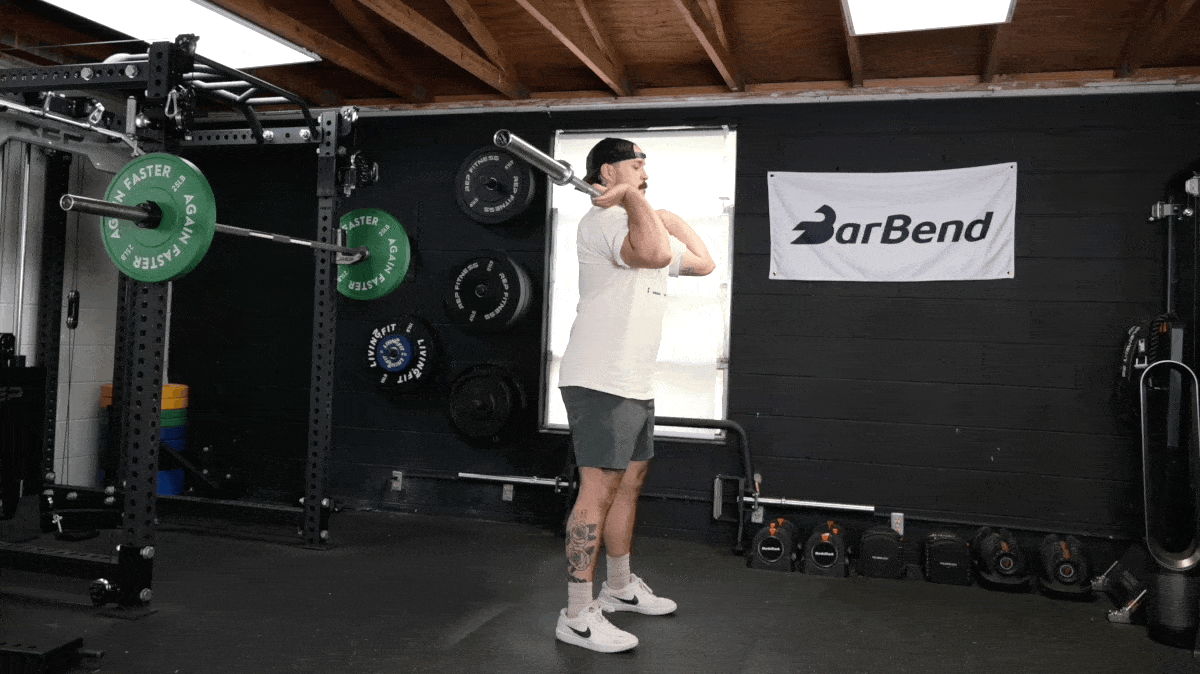
Plus, the lower body dip allows you to lift more weight overhead than the barbell overhead press. Lifting more weight overhead allows for more muscle and strength.
How to Do It
- Stand in front of a loaded barbell, set to about chin-height in a power rack.
- Grab the bar with a grip that’s slightly wider than shoulder-width.
- Brace your abs, dip your knees a little bit, and then explosively push the bar overhead.
- Catch the bar gently on your chest and then repeat.
Coach’s Tip: Think about initiating the movement with just your legs and pressing with your arms only after the bar clears your head.
Sets and Reps: Go for 4 to 5 sets of 3 to 5 reps.
8. Barbell Hip Thrust
Using the hip thrust will build both strength and mass in your glutes. Though the glutes are worked during the back squat and deadlift, the hip thrust is as close to an isolation movement as exists for the glutes.
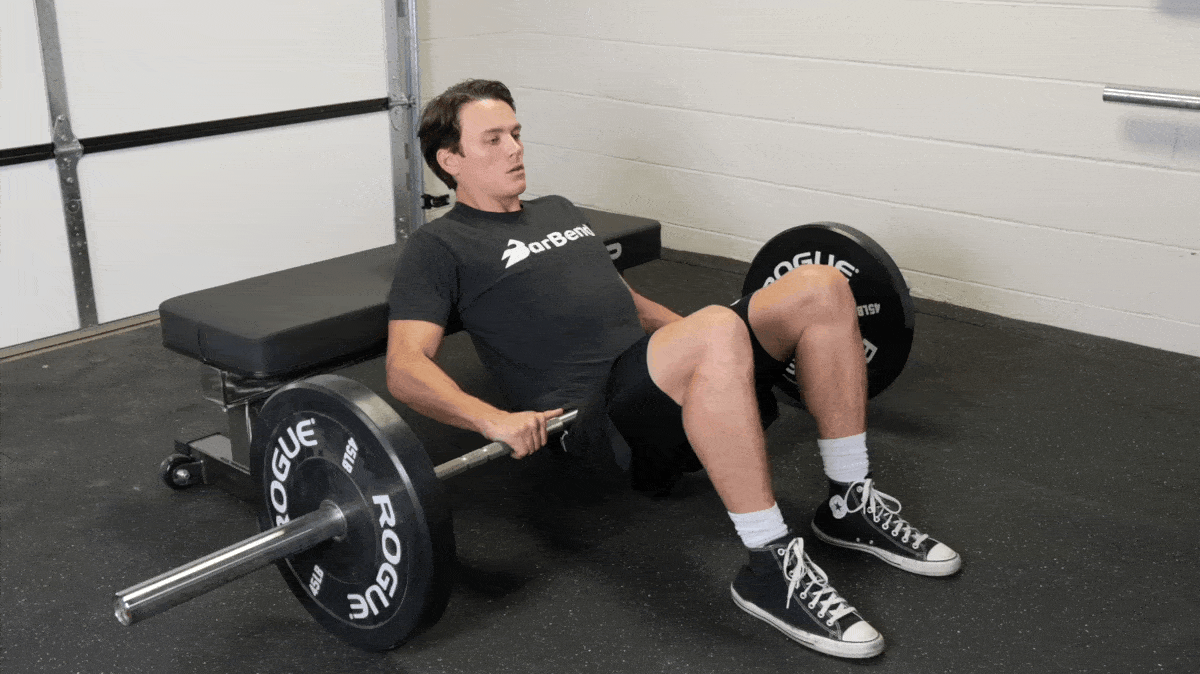
And honing in on the glutes will carry over to those movements and make you a more efficient runner, jumper, and sprinter. Plus, you’ll look great in your favorite pair of pants.
How to Do It
- Sit with your back up against the edge of a bench that’s parallel to you.
- With padding across your pelvis, roll a loaded barbell into the crease of your hips.
- Once the barbell is secure, drive your feet and back towards the bench. You want your shoulder blades to be on the bench and upper body and hips in a straight line.
- Keep your upper body steady as you lower your hips toward the ground and when extending into lockout.
Coach’s Tip: Actively drive your upper back against the bench as you thrust.
Sets and Reps: Do 4 sets of 12 to 15 reps.
9. Barbell Floor Press
The barbell floor press is a great option for lifters looking to strengthen the top portion of their press. By pressing a barbell from the floor, you’re limiting your range of motion and focusing more on triceps and lockout strength.
[Read More: The 10 Best Grip Strengtheners On the Market]
This means you can typically press more weight than other dumbbell bench press variations. That can equate to a stronger bench press and bigger triceps. This is always a great option when all the benches are taken, or you need to work around shoulder issues.
How to Do It
- Lie down in front of a power rack. Extend your arms. Adjust the hooks so that the barbell sits where your hands reach.
- Plant your feet firmly on the floor.
- Grab the bar with your typical bench press grip.
- Lift the bar out of the rack. Lower it to your sternum. Keep your elbows tucked in at 45 degrees. Press back up.
Coach’s Tip: Lower the weight down until your elbows barely touch the floor. Make gentle contact.
Sets and Reps: Try 2 sets of 12 to 15 reps.
10. Barbell Biceps Curl
There are many biceps curl variations, but the barbell biceps curl is the granddaddy of them all. If your wrists and elbows are healthy, this variation will allow you to curl more weight and increase strength and mass.
Bicep strength plays an important role in pulling from the floor and row and pull-up variations. If your biceps are a weak link, then you will not get the best out of these exercises. Strengthening them allows you to build more strength and mass with these pulling exercises.
How to Do It
- Hold a barbell with an underhand grip. Your hands should be slightly wider than hip-width.
- Keep your shoulders back and down. Curl the barbell up towards your shoulders.
- Let your elbows drift forward while locking your shoulder in place.
- Pause and squeeze your biceps at lockout. Slowly lower, keeping a tall posture. Reset and repeat.
Coach’s Tip: Keep your upper arms pinned tightly to your sides and don’t sway at the hips.
Sets and Reps: Do 4 sets of 6 to 8 repetitions.
11. Barbell Hang Clean
The hang clean is similar to the power clean, which is a staple in most high school, college, and professional weight rooms. But the hang clean has a shorter learning curve. This is because you’ll generate power from a friendlier low back position.
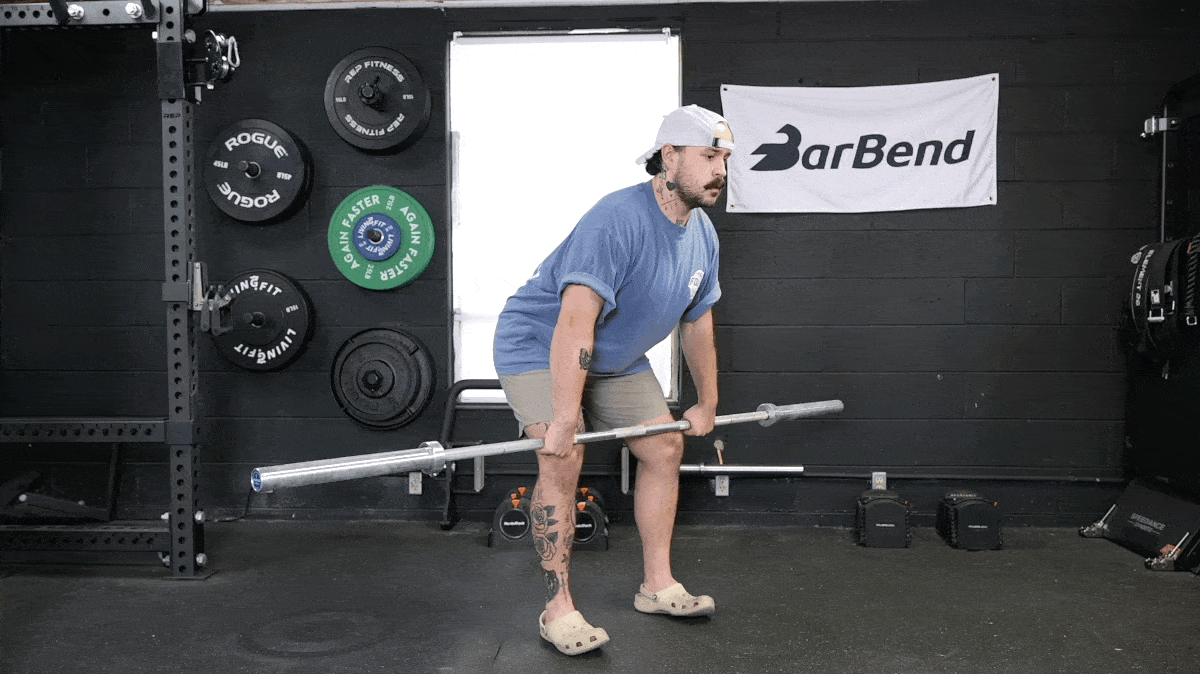
This exercise still requires a powerful hip drive, a strong pull, and dip and catch — just like the power clean. And the hang clean will still build slabs of upper back strength and mass. Plus, it is less stressful on the lower back, which is great if you tend toward low back pain.
How to Do It
- Stand tall with the barbell at arm’s length with an overhand grip. Place your feet shoulder-width apart.
- Hinge at your hips until the bar is at knee height. Push your feet into the floor and explosively pull the barbell.
- Keep your chest up and the barbell close to your body. Pull until the bell is in your hip crease.
- Snap your hips forward and pull the bar up to your shoulders.
- As the bar continues up, drop into a squat. Catch the bar in the front rack position. Your elbows should be up and facing forward.
- The barbell should be at your collarbone. Squat up until lockout. Reset and repeat.
Coach’s Tip: Maintain balanced foot pressure as you hang, don’t sit back too far onto your heels.
Sets and Reps: Go for 4 to 5 sets of 2 to 4 repetitions.
12. Barbell Good Morning
Barbell good mornings are a fantastic move that trains the lower back, glutes, and hamstrings all at once. This exercise needs to be mastered with lighter loads before increasing intensity and range of motion.
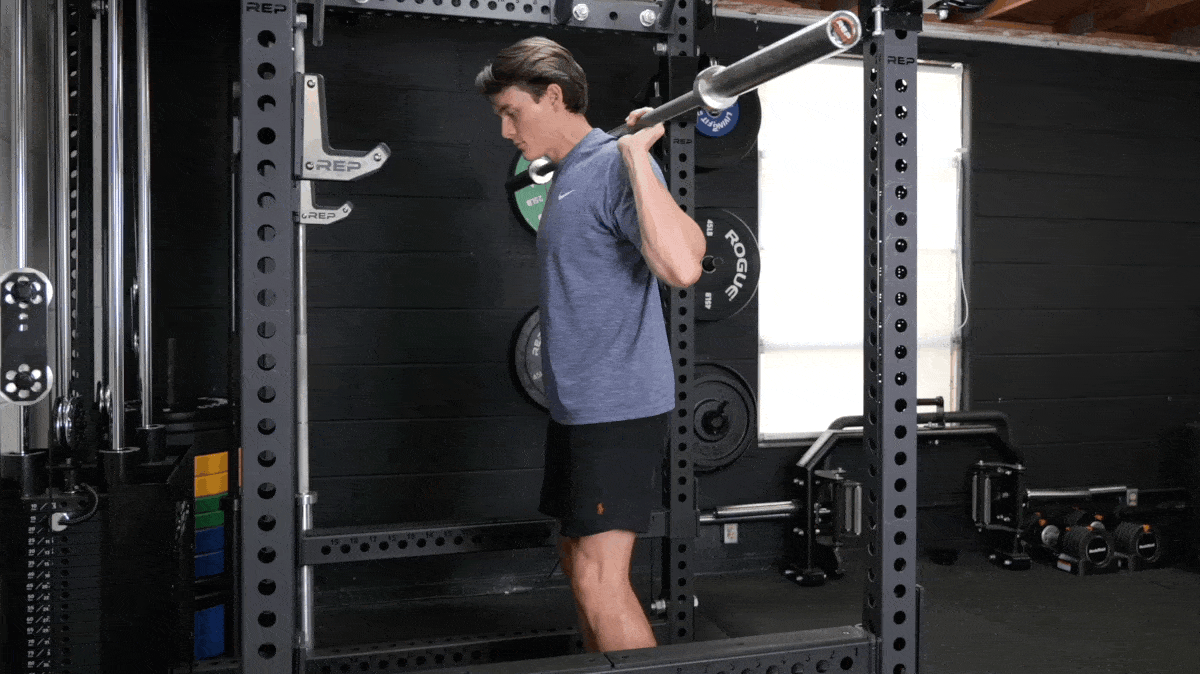
When you do it right, this exercise will build and strengthen posterior chain. In turn, this will help build a stronger and healthier squat and deadlift performance.
How to Do It
- Step into a squat rack. Unrack the barbell on your traps.
- Walk out two or three steps. Hinge at your hips with a slight bend in your knees.
- Keep your chest up and shoulders down. Hinge until your torso is almost parallel to the floor.
- Contract your glutes and hamstrings to lift yourself to a standing position. Reset and repeat for reps.
Coach’s Tip: Start with less weight than you think you need for good mornings.
Sets and Reps: Try 2 sets of 15 repetitions to begin with.
13. Barbell Kirk Shrug
Kirk shrugs got their name from the guy who first used them, world champion powerlifter Kirk Karwoski. He started doing this shrug variation to improve his grip strength for the deadlift. Because this shrug variation uses a thumbless grip, the focus is on the upper back and grip strength.
Yes, it improved his deadlift, but it built an impressive yoke, too. If you’re looking to build upper traps, Kirk shrugs need to be your go-to.
How to Do It
- Place a barbell at thigh height in a squat rack. Grip the barbell with a thumbless overhand grip or suicide grip.
- Shrug the weight by using your only traps.
- Keep your shoulders down and your chest up. Pause for a second at the navel.
- Slowly lower the barbell down to the starting position.
Coach’s Tip: Lean forward slightly to increase your range of motion.
Sets and Reps: Do 2 or 3 sets of 15 to 20 repetitions.
14. Barbell Overhead Carry
All carry variations are great, but the barbell overhead carry takes carries to a whole new level. Overhead carries puts your whole body under tension. Every step is a test of your single-leg balance.
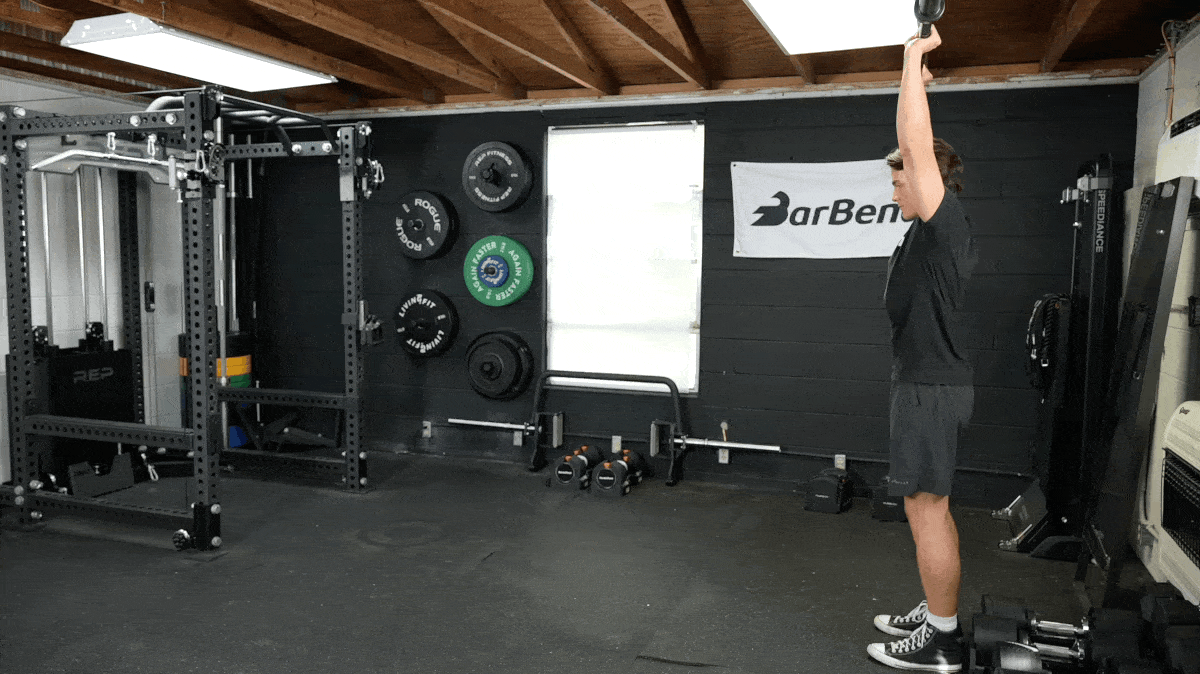
Your upper back and traps get serious time under tension for improved muscle and strength. Plus, the barbell overhead carry improves overhead lockout strength, mental conditioning, and toughness.
How to Do It
- Load the barbell with somewhere between 60 to 80 percent of your overhead press one-rep max.
- Place your hands slightly wider than shoulder width. Press the barbell overhead.
- Take slow, deliberate steps. Pay attention to your gait and balance.
- Walk for 20 to 40 yards. Re-rack the barbell in the squat rack or place it on the ground. Rest and repeat.
Coach’s Tip: Your arms should be just behind your ears in the overhead position.
Sets and Reps: Try 3 or 4 rounds of overhead carries.
15. Barbell Skull Crusher
The barbell skull crusher has you lower a barbell to your forehead to stretch the triceps muscle before you contract it. Exercises like the barbell skull crusher put your muscle groups through a larger range of motion. This translates into better hypertrophy potential.
[Read More: 5 Bench Press Programs to Build a Bigger, Stronger Chest]
The barbell skull crusher allows you to isolate the triceps — specifically the long head of the triceps, which is responsible for a lot of arm thickness. This exercise is also performed in a position that also allows you to move heavier weight than you could with other triceps variations.
How to Do It
- Start by lying on a bench with a barbell in your hands.
- Set up your back and hips like you do for a bench press.
- Pull your elbows back slightly so that they are pointing behind you as you bend your elbows.
- Lower the bar handle toward your head.
- The bar should nearly contact your forehead. When you feel a stretch on your triceps, push the bar back up.
Coach’s Tip: Brace your core to keep your torso and legs secure on the bench and prevent cheating.
Sets and Reps: Try 3 or 4 sets of 10 to 12 reps.
Barbell Exercise Warm-Up
It is always important to warm up to get the muscles and joints ready for a heavily loaded barbell. There are two ways to go about this. First, you’ll start with a mobility routine. This will get your muscles and joints ready for the ranges of motion expected with barbell exercises.
Especially when working with a barbell, try to prioritize exercises that train shoulder, thoracic spine, hip, and ankle mobility. Here is a 5-minute mobility workout routine that can get your body ready for the barbell in a hurry. Cycle through these movements more than once (or twice) if you can.
- Bodyweight Side Lunge: 10 reps per side
- 3-Way Ankle Mobilization: 8 – 10 reps
- Back to The Wall Shoulder Flexion: 8 reps
- Walking Spiderman with Hip Lift and Overhead Reach: 5 reps per slide
- Floor Slide: 10 reps
After your mobility routine, you’ll want to perform ramp-up sets as an extended warm-up. These sets grease the groove and help you determine your working weight for the day by how easy or hard a certain weight feels. The extra volume is also helpful for fat loss and muscle gain goals.
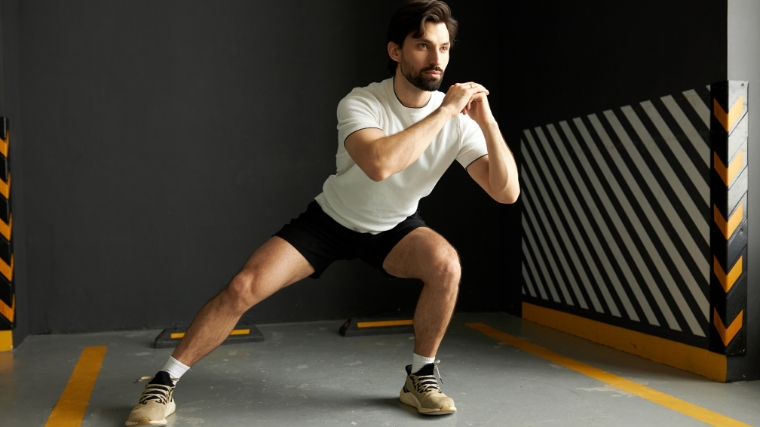
[Read More: The Best Full-Body Bodybuilding Workout for Beginner to Advanced Lifters]
Even though you’ll be working at times with very light weight — always start with an empty barbell — respect the barbell and act as if it were loaded heavily. This will ingrain proper movement patterns so that your body will be truly ready to handle heavy loads.
Here’s an example of a ramp-up sets for barbell deadlifts:
- 45 (empty barbell) x 10 reps
- 135 x 8
- 155 x 6
- 165 x 5
- 175 x 4
How To Train With a Barbell
A barbell is a tool that allows you to load and move the most weight, compared to other strength training implements. The barbell loads fundamental movement patterns like the squat, press, and various pulls with progressively heavier weights allowing you to get bigger and stronger.
But the barbell can be unforgiving because it locks you in certain ranges of motion and doesn’t have as much freedom of movement as dumbbells. This means certain joints can get angry with too much barbell lifting. Keeping barbell movements between 25 to 50 percent of your programming can help ensure that you’re performing exercises that are easier on your joints — and less likely to develop strength and muscle asymmetries.
Exercise Order
To program barbell lifts successfully while keeping your training balanced, you need to consider how you prioritize your exercises. Compound barbell exercises — those that work the most muscles — should pretty much always come first in your programming. This is when you have the most energy from your warm-up and your muscles are yet not fatigued. Exercise like barbell squats, barbell presses, or power moves like the hang clean and push press need total body engagement.
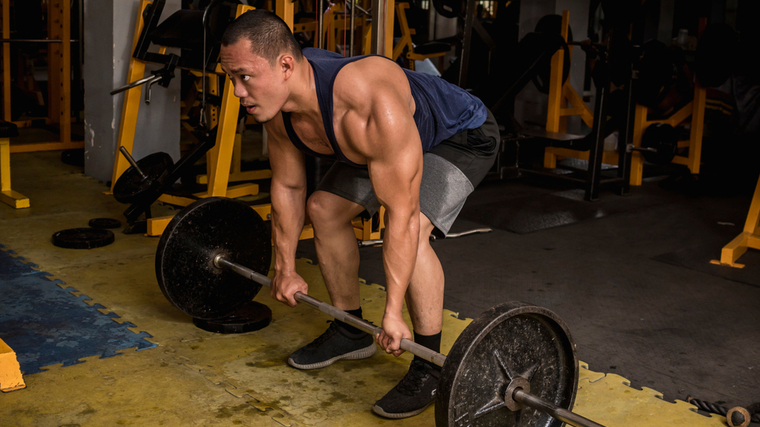
When training two strength movements in the same session, use your best judgment on what comes first. Try to avoid putting two exercises on the same day that put a compressive load on the spine.
Program barbell accessory movements to work on weakness like skull crushers, biceps curls, or Romanian deadlifts will come after your main lifts. Then, program more isolated, lighter-weight accessory movements such as those performed with dumbbells or cable machines.
Strength Sets & Reps
Muscle and strength is built in a variety of set and rep ranges. When you’re focused on building max strength, you’ll generally want to work with a load of 85 percent of your 1-RM. Keep the total reps performed between 10 and 25 reps. This can be broken up into various set and rep schemes: think three sets of five reps, five sets of five reps, four sets of six reps, or five sets of two reps.
Muscle Sets & Reps
Most of your barbell accessory work falls under hypertrophy and endurance training. The focus here is on volume and increasing time under tension to provide the right stimulus to build muscle. As with strength, muscle is built within a variety of load sets and reps. For maximum hypertrophy, try working in the six to 12 rep range with a weight that makes you approach failure at the end of your set. A good rule of thumb is that if you’re performing less reps, use a heavier load and more sets. If you’re doing more reps, use a lighter load and fewer sets.
Benefits of Barbell Training
The major advantage the barbell has over other weighted equipment is the ability to move weight in a straight line over your center of balance. For example, when performing the squat and deadlift, even a slight deviation from a straight bar path usually results in a missed lift due to poor technique.
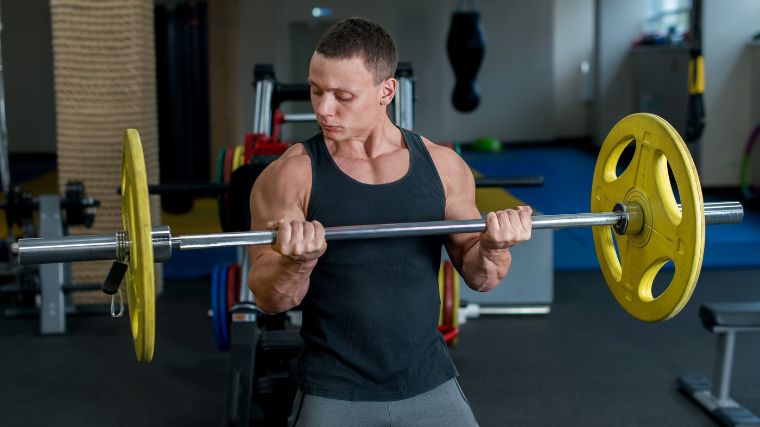
[Read More: The Ultimate 10-Week Powerbuilding Workout Routine for Mass and Strength]
The barbell loads fundamental human movements — like the squat, overhead reach, and hip hinge — with progressively heavier weights allowing the lifter to get bigger and stronger. Here are some other important benefits of using a barbell.
Versatility
No matter the goal — fat loss, strength, hypertrophy, or improving athletic performance — the barbell will help get you there faster.
Progressive Overload
Barbells make it easy to add weight to, and you can load up to your max for progressive overload. The same cannot be said for other free-weight equipment. Dumbbells, kettlebells, and machines only go so high, and their resistance is predetermined.
Better Stability
The barbell is fixed and stable, and so and it’s less likely to deviate from its range of motion, unlike dumbbells and kettlebells. When you’re lifting heavy, this lack of deviation of the path of the barbell makes it less likely you’ll get injured when lifting with good form.
More Barbell Training Tips
Now that you have a handle on the best barbell exercises to strengthen and add mass to your body, you can also check out these other helpful barbell training articles for strength, power, and fitness athletes.
References
- Michal Wilk et al. Endocrine response to high-intensity barbell squats performed with constant movement tempo and variable training volume. Neuro Endocrinol Lett 2018 Oct;39(4):342-348.
- U Wisløff et al. Strong correlation of maximal squat strength with sprint performance and vertical jump height in elite soccer players. Br J Sports Med. 2004 Jun;38(3):285-8
Featured Image: Photology1971 / Shutterstock
The post The 15 Best Barbell Exercises For Mass, Strength, and Power appeared first on BarBend.
